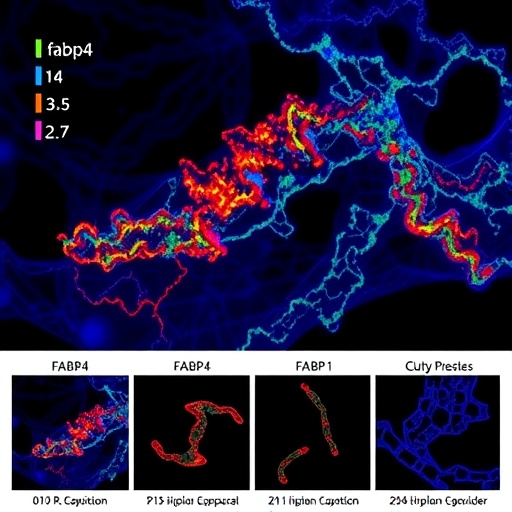In a groundbreaking study that could reshape our understanding of osteosarcoma treatment strategies, researchers have unveiled that hispidulin, a promising natural compound, exerts its anti-cancer effects by targeting fatty acid-binding protein 4 (FABP4). This revelation, articulated in a recent publication, emphasizes the compound’s potential to disrupt lipid metabolism and inhibit the notorious PI3K/AKT signaling pathway, which is frequently altered in cancerous cells. The study, led by Yuan et al., suggests that manipulating these biomolecular pathways might provide a novel approach for combating one of the most aggressive childhood cancers.
Osteosarcoma remains a formidable challenge in oncology, particularly among adolescents and young adults. The complexity of its pathogenesis, characterized by genetic mutations and aberrant signaling pathways, has historically limited effective therapeutic options. Current treatments, primarily involving surgery and chemotherapy, often lead to severe side effects and high relapse rates. Therefore, the search for new, less toxic therapeutic agents is more critical than ever. This is where hispidulin emerges as a beacon of hope.
The role of lipid metabolism in cancer biology has garnered increasing attention in recent years. Recent findings highlight how cancer cells can become reliant on altered lipid metabolism to fuel their growth and survival. In this context, FABP4 has been identified as a crucial player, transporting fatty acids and participating in the regulation of several metabolic pathways. By targeting FABP4, hispidulin directly impacts lipid homeostasis, thus presenting a viable method for hindering tumor proliferation.
Furthermore, the study elucidates how hispidulin’s modulation of FABP4 levels not only disrupts the lipid metabolism process but also influences the PI3K/AKT pathway. This pathway is integral to cell proliferation, survival, and metabolism, making it a prime target for cancer therapeutics. In osteosarcoma, aberrant activation of the PI3K/AKT pathway is frequently observed, underscoring the significance of interventions aimed at re-establishing control over this signaling cascade.
Employing a combination of in vitro and in vivo experiments, the researchers demonstrated that hispidulin treatment resulted in reduced proliferation rates of osteosarcoma cells. Additionally, the compound induced apoptosis—an essential process for eliminating cancerous cells—thereby leading to a marked reduction in tumor size in preclinical models. The findings are not merely a demonstration of efficacy; they offer mechanistic insights that could pave the way for the development of targeted therapies based on hispidulin.
The implications of this research extend beyond the laboratory setting. Should hispidulin undergo clinical trials and prove effective in human subjects, it could significantly alter the therapeutic landscape for osteosarcoma patients. This compound’s ability to selectively target metabolic pathways indicates a future where precision oncology becomes the norm; therapies may be tailored not only to the genetic profile of a tumor but also to its metabolic dependencies.
While the findings are undoubtedly promising, challenges remain. For instance, understanding the bioavailability of hispidulin when administered in vivo could influence its clinical applicability. Moreover, further investigations are necessary to determine the potential side effects and long-term implications of hispidulin treatment. Researchers underscore the importance of conducting rigorous clinical trials to validate the efficacy of hispidulin and ensure its safety for patient use.
As researchers continue to unlock the therapeutic potential of phytonutrients like hispidulin, the hope is that more natural compounds will be identified that can provide similar, or even enhanced, benefits in cancer treatment. Given the growing body of evidence linking lipid metabolism and cancer, this could signify the dawn of a new era in oncology, where natural and less toxic compounds are at the forefront of therapeutic interventions.
In the broader context of cancer research, the significance of this study lies in its contribution to an evolving paradigm that recognizes the complexity of cancer biology. The interplay between metabolic rewiring and oncogenesis signifies that future cancer therapies may not solely focus on targeting genetic mutations but also on altering the metabolic state of tumors. Hispidulin’s multifaceted action positions it as a model for future research aimed at combining metabolic interventions with traditional oncological strategies.
In conclusion, the findings presented by Yuan and colleagues provide a compelling argument for further exploration of hispidulin as a therapeutic agent against osteosarcoma. By tackling the dual issues of lipid metabolism and aberrant signaling pathways, hispidulin could represent a critical advancement in the quest for efficacy in cancer treatments. The ongoing research is eagerly anticipated, with the hope that this natural compound may one day become a staple in the arsenal against one of the most challenging cancers in modern medicine.
The journey from laboratory discoveries to clinical application is often fraught with challenges, yet the innovative pathways unveiled in this study could pave the way for more effective cancer therapies. The discourse surrounding natural compounds in oncology continues to grow, and hispidulin stands as a prime example of how nature can provide solutions to some of medical science’s most pressing problems.
Ultimately, the integration of novel compounds like hispidulin into cancer management protocols could not only improve patient outcomes but also enhance the quality of life for those affected by osteosarcoma. As research progresses and clinical trials commence, the scientific community remains hopeful that we are on the cusp of significant breakthroughs in the treatment of osteosarcoma and, indeed, other malignancies.
Amidst these hopeful assertions lies the necessity for continued support of cancer research initiatives. Funding and resources devoted to exploring the potential of compounds like hispidulin are vital in driving these discoveries to fruition, ensuring that the promise of better therapeutic options translates into tangible benefits for patients worldwide. The fight against cancer is ongoing, and every innovative discovery brings us one step closer to achieving the long-sought goal of eradicating this devastating disease.
In summary, the impact of hispidulin on osteosarcoma is not just a story about a promising compound; it’s a reminder of the myriad opportunities that exist when science, nature, and innovation intersect. As we look to the future, the potential for hispidulin to revolutionize treatment paradigms becomes more tangible, a testament to the power of research and the enduring pursuit of knowledge in the relentless battle against cancer.
Subject of Research:
Article Title: Hispidulin suppresses osteosarcoma by directly targeting FABP4 to disrupt lipid metabolism and inhibit the PI3K/AKT pathway.
Article References:
Yuan, X., Yu, S., Zeng, Z. et al. Hispidulin suppresses osteosarcoma by directly targeting FABP4 to disrupt lipid metabolism and inhibit the PI3K/AKT pathway. J Transl Med 23, 1062 (2025). https://doi.org/10.1186/s12967-025-07128-4
Image Credits: AI Generated
DOI:
Keywords: Cancer, Osteosarcoma, Hispidulin, FABP4, Lipid metabolism, PI3K/AKT pathway, Natural compounds, Oncology, Therapeutics.
Tags: adipocyte-derived factors in tumorsFABP4 targeting in osteosarcomagenetic mutations in osteosarcomahispidulin anti-cancer propertiesinnovative approaches to cancer therapyless toxic cancer therapieslipid metabolism in cancer treatmentmetabolic dysregulation in cancernatural compounds in oncologynovel therapies for childhood cancersosteosarcoma treatment strategiesPI3K/AKT signaling pathway inhibition





